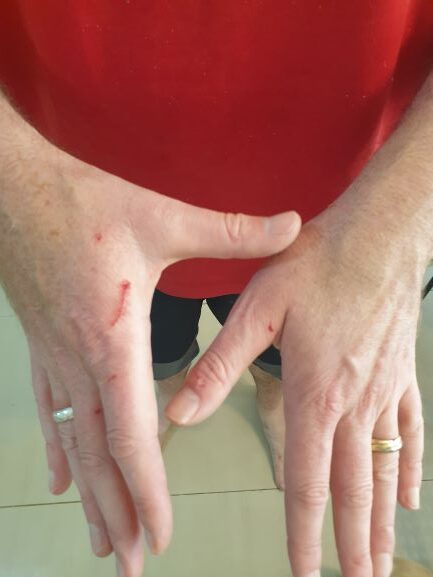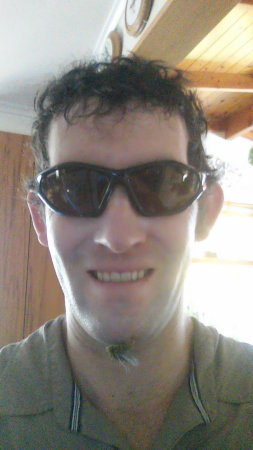The weather was absolutely brilliant today, but I was stuck at home waiting for family to visit in the afternoon, so I decided to sneak out for a short ride, as I was powering home, my chain momentarily got stuck and I slammed my toes directly into the asphalt. The pain was immediate, but it got me thinking, about what other injuries I had while enjoying my hobbies, and then I decided it would be a decent topic to write about on a lazy Saturday.
So, these are the most common injuries I suffer while trout fishing.
I first feel like I should note, that injuries are extremely rare and usually minor. I have never required medical treatment for any of them, and any pain or discomfort is gone within a few days,
I have decided to split the fishing injuries into three categories, punctures, scratches, and strains
Punctures – AKA Cicada fly in my chin
I suspect many new fly fishermen might just hook themselves more than they hook fish, it is all so easy to do, and have done it numerous time. Although, it the fly usually just gets stuck in my clothing, requiring awkward stretching to get it out.
Occasionally, I do get a hook in the skin, most of the time they are not deep, and they pull straight out, a few spots of blood, but not worth losing any fishing time over.
Once, I managed to hook my chin extremely well, a really solid hookup. It was a warm summer afternoon, and I was fishing large cicada flies beneath overhanging vegetation when I caught a willow branch.
Not wanting to disturb the fish, I tried to flick the snag free, but eventually had to pull it off with force. Normally the knot or line will break, but this time, maybe due to the heavier tippet the fly itself comes rocketing back towards me smacking me straight in the chin. Ouch.
There was still fishing to be had, so not knowing where the fly was I decided to roll cast it free, then ouch again. The fly was in my chin and the roll cast probably just forced it in deeper. Like any keen trout fisherman, I did the only sensible thing and cut the line, before tieing on a new fly to continue fishing.
Half an hour or so later, I decided I probably should do something about the fly in my chin, so I drove home where I spent the next half hour slowly working it back out. This was a good reminder, to always, and I mean always flatten the barbs. Not only is it gentler on the fish, it is also gentler on our skin. It is also a good time to mention, always wear glasses when fishing, a fly in the chin hurts, a fly in the eye is a hospital visit.
Scratches, cuts, and grazes

This section is fairly self explanatory. There are plenty of things in nature and when fishing that can break out skin.
Sometimes, I will trip over and lose a little skin, or maybe I grab a fish the wrong one and get a spine in the hand, although trout in general do not have sharp spines. They are quite safe to handle.
Trout also have tiny teeth, and they are unlikely to bite. But other species of fish deserve more respect, pike have impressive fangs. Bit off-topic, I once got bitten by a shark once when I put my hand into its mouth to remove a deep hook. My stupidity is entirely to blame, I should have gotten long nosed pliers but I wanted to get her back into the water as soon as possible so took the risk. Fortunately, sharks and most bity fish are rarely encountered when trout fishing. Although I once caught a brown trout while shark fishing. No idea what it was doing in the sea.
Getting back to the topic. One of the main sources of cuts is from the fishing line itself. A thin fishing line can be rather sharp, and wet hands and saturated hands can become extremely soft. This makes line cuts extremely easy to get.
I use to do a lot of kayak fishing, using braided fishing lines. My hands were covered in cuts, some of them which will never fully heal because with each trip the braid will find the old wound again. Was quite unpleasant. I started to wear gloves.
Strains aka twisted ankles and knees
When trout fishing we often walk over slippery, uneven terrain. More often than not, we will be scanning the water for signs of fish rather than watching our foot placements. So sooner or later, anyone who spends time outdoors will roll an ankle, or slightly injure a knee. It happens, and it can be quite painful.
Most strains, are fairly minor and can usually be walked off, or they will heal over a few days of the week, but sometimes they can be bad.
I am lucky, I seem to have very strong ankles, so they rarely roll. The problem with strong ankles is that the ‘strain’ has to go somewhere and it normally travels up my leg to my knees. From bad foot placements, I have had a couple of quite painful knee injuries. They were not much fun.
My worst strain was actually getting out of a sit inside kayak, the cockpit was a bit tight for me so I had dead legs, and I tried to stand before regaining my circulation and over I went into an icy cold mountain lake. At the time of the fall, I did not feel much pain because everything was numb from the cold. After the drive home, it was very bad.
Probably should have gone to the doctor, but decided to walk it off. Was painful for several months afterward.
What is the best way to prevent strains, will wear proper wading footwear and step between rocks and boulders and not on them. I have also seen people using stepping stones, yeah, their feet will remain dry a few minutes longer but they are very unstable.

